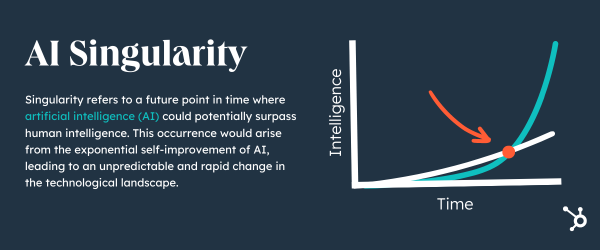If you’re working in a marketing role, you can’t ignore the emerging field of artificial intelligence. It’s quickly gained traction, and industry leaders have begun projecting that rapid AI advancements could surpass human intelligence sooner than we think.
But what does that mean? And what are the implications of that type of advancement? As a marketer, it can be challenging to imagine where AI technology will go. However, understanding AI singularity, including its implications and potential outcomes, can help you stay ahead of the curve in an ever-changing profession.
So before we discuss AI singularity in modern-day terms, let’s talk about the original or blanket term — technological singularity.
Technological Singularity
Technological singularity is the idea that, at some point in the future, technology will become so advanced that it surpasses human intelligence and control, and was first coined in 1983 by the author Vernor Vinge.
So how can we visualize this concept with today’s AI technology? Let’s dive into it.

AI singularity involves the creation of an artificial intelligence that’s so advanced, it can continuously improve upon itself at a rate that’s faster than humans performing the same task. This rapid self-improvement leads to an intelligence explosion, with AI algorithms becoming more complex and powerful at an exponential rate, exceeding the cognitive capabilities of individuals.
While it sounds useful for technology to conduct tasks and operations that humans haven’t achieved, it could have far-reaching implications for how we approach AI and its applications.
AI Singularity Implications
Assuming AI singularity occurs, the implications for businesses and, generally, any technology company might be significant. AI entities that are more intelligent than humans could self-replicate and self-improve, resulting in a chain of increasingly more advanced AI machines.
That improvement and development of AI would cause a dramatic shift in the labor market. Machines could increasingly displace human workers, particularly those who have engaged in routine and manual labor, while the demand for more sophisticated high-tech skills would continue.
How Close Are We to AI Singularity?
There have been significant advances in technology, including machine learning algorithms that have shown promising results in problem-solving applications. However, given the complex and multifaceted nature of human intelligence, creating a fully autonomous AI entity that exceeds human intelligence still seems like a long-term goal.
However, futurist and computer scientist Ray Kurzweil has made predictions that singularity will approximately occur in 2045, while others speculate the tipping point is earlier than that.
Life After Singularity
It’s difficult to predict precisely what life will look like beyond the point of singularity. The risk is that implementing increasingly advanced AI machine learning could affect its actions and decisions, including those that could be unpredictable, poorly made, or even harmful to the world.
The benefits of singularity, however, cannot be overstated. AI singularity could play a significant role in helping to solve many of society’s most vital problems, and even alleviate some of the day-to-day pressures that come with a busy, productive working population.
But once again, we’ll only speculate as we continue to ingrain our lives and work with AI technology.
![]()
![Free Guide: How to Use AI in Content Marketing [Download Now]](https://no-cache.hubspot.com/cta/default/53/3e25e192-30c3-40c1-a7da-a4d054c9e157.png)
